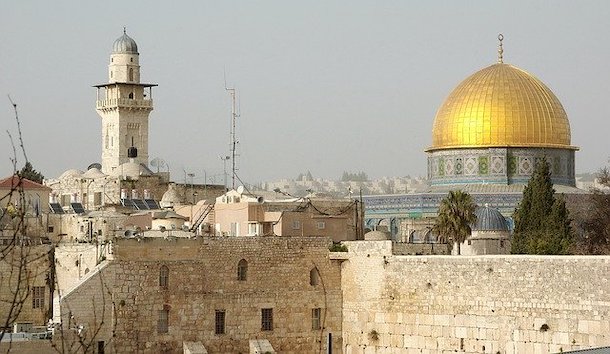Part One: The Plan
The conflict in the Holy Land is older than any mainstream media pundit of note. Most of them have spewed ill-informed drivel on President Donald Trump’s plan for Israeli-Palestinian peace because they are ignorant of geography or history. They talk of “Jerusalem,” but don’t know the difference between the Jerusalem Municipality and the city of Jerusalem. They talk of the “West Bank settlements,” as if Ma’ale Adumim (pop. 42,000) was a settlement in the same league with Negohot (pop. 350). The devil is in the detail, indeed.
As it happens, I have just returned from my sixth tour of Israel, a 16-day, 2,500-mile trek which also included all three areas of the Territories, much of Jordan, and the South Sinai Governorate of Egypt. For a week I rented an apartment across the Green Line at Har Adar, on a hilltop from which you can clearly see the sea to the west and Jordan to the east. I’ve driven the length of Highway 90 from Capernaum, along the Jordan Valley, the western shore of the Dead Sea and the Negev to Eilat. I observed the lay of the land from two time-tested vantage points, the Mount of Temptation above Jericho and Mount Nebo south of Amman.
I may write a gracefully lyrical travelogue on all those interesting places one day; but for now, back to the Plan, sanguinely named “Peace to Prosperity: A Vision to Improve the Lives of the Palestinian and Israeli People.”
It is incorrect to claim that the 181-page document, presented at the White House ceremony on Jan. 28, finally takes a sober and pragmatic view of the Israeli-Palestinian dispute. Evidently it is not, as its authors claim, “the best, most realistic and most achievable outcome for the parties.” It is also incorrect to assert that it is a complete nonstarter, merely calculated to cement Trump’s evangelical base, to help his friend Bibi win the next general election on March 2 and to give him a free annexationist hand thereafter. The “Deal of the Century” is a bit of both, though not in equal measure.
As for realism, it is clear there’s a price to pay when the weaker party in a conflict rejects compromise, as the leadership of the “Palestinian national movement” has done over the decades. Far from leading to improved packages, for the past two decades this attitude has resulted in progressively degraded offers. A viable Palestinian state seemed realizable a quarter of a century ago. However, bitter intra-Palestinian rivalries favoring intransigence, misleading advice of the third parties, and above all the irrational but obstinately enduring belief that Israel was an impermanent phenomenon, have all conspired to undermine opportunities for its creation.
A generation ago, Israel pursued the Land-for-Peace framework which produced the Oslo Accords in 1993. It did so under the premierships of Yitzhak Rabin and Shimon Peres (1992-1996), which cost the former his life. By the end of 2000, however, with Yasser Arafat’s final rejection of Bill Clinton’s Camp David proposal, it had become clear—as former PM Ehud Barak reluctantly admitted—that the Israelis had “no Palestinian partner for peace.”
The Palestine Liberation Organization (PLO) is still Israel’s partner of sorts. Of course, it has long ceased to be a revolutionary “movement of national liberation.” Instead of developing into a state-building force, however, it has morphed into a corrupt machine whose beneficiaries have learned how to live comfortably within the status quo. Worse still, they fear any change in the equation. For most PLO apparatchiks it is far easier and personally safer to stick to the fiction of a future “Palestine” from the Jordan to the sea, while reaping the benefits—some of them legal—which the institutions of limited autonomy provide.
One consequence of this sordid arrangement is that there is no peace plan in existence now, and there may never be one, which will be satisfactory to the Palestinian Authority stakeholders as long as it requires their recognition of Israel as the permanent and legitimate Jewish state, within whatever borders. Another is that the Arab “street” and all key Arab governments have grown remarkably indifferent to the so-called Palestinian cause. This was evidenced by Jordan’s aloof posture, which I witnessed firsthand on the day the plan was unveiled.
The “realist” defenders of Trump’s plan accordingly argue that the structural problem in the Arab-Israeli conflict is not territorial, but ideological and religious. Whatever the proposed border, for a believing Muslim no permanent peace is possible because it is against Allah’s will to grant any piece of land once controlled by the faithful, the Dar al-Islam, to non-Muslim infidels, the Dar al-Harb. This notion is embraced with particular zest by Palestinian politicians of all color and hue, not just the Hamas and Hizballah hardliners.
(Part two of this essay, “The Disagreeable Agreement,” will continue on Thursday, Feb. 13).
[Image via Albert Dezetter from Pixabay.]

Leave a Reply